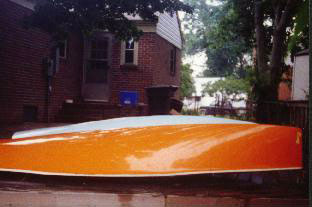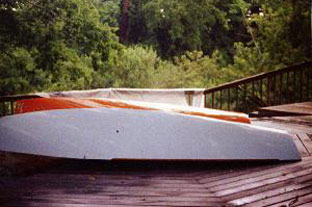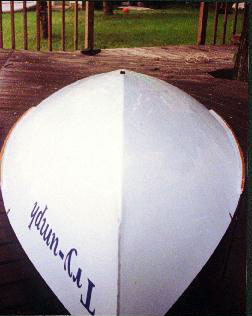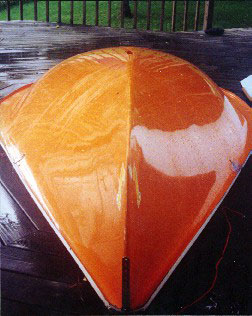

The mistral (blue) and skol (orange) hulls compared. The skol has less rocker and a flatter cross section.


The skol hull before the project started. The vestigial wings were removed to meet the CMBA max concavity of 1" aft of the well.
Stuff I Had to Get
- Plywood for bulkheads, decks and tank panels: 3-mm okume marine plywood. Available from Harbor Sales in Baltimore, Yukon Lumber in Norfolk, and Berlin G. Myers in Summerville SC. Price approximately $30 per sheet. Four sheets required.
- Resin - Hardener - ect: Gudgeon Brothers WEST resin and hardener was used with a couple of fillers: colloidal silica and microballoons. I used two gallons of resin and two quarts of hardener (I used the fast hardener). Also from WEST I used the metering pumps, two large containers of low density fairing/filling compound (the micro balloons) and one large container of thickener (the colloidal silica), and about three dozen throw-away "acid " brushes for mixing resin. Also needed is about 50 feet or 2" wide fiberglass tape to tie the bulkheads to the hull. To mix the resin in I used the bottom half of 1 gallon milk containers. Latex gloves kept the mess manageable; I found a box of 100 at a discount warehouse.
- Sanding the deck surface was done with a 5" Dewalt dual action sander. The hook and loop discs have eight hole in the surface which allow the dust to be sucked up. Hooking a shop vac to the sander discharge allows the shop to keep relatively dust free (although working outside is even better!).
- The staples were fired from a regular Stanley staple gun. I think I used 3/8" long staples.
- Most of the timber was western red cedar I got from a local Home Depot. They sell individual 8' x 4" x 3/4" fence pickets for about $3 apiece. The tank "ribs" were sawn from 3/4" exterior grade plywood. I used a band saw, a handheld jig saw, an electric drill, about a dozen C-clamps.
- As my garage is not heated, heat lamps allow the resin to kick in a reasonable amount of time when working in the winter. Many of the materials react differently at different ranges of temperature and humidity.
- Exercise caution when heating the work area as many of the materials are flammable.
- Wear protective gloves… to minimize skin contact with these materials to prevent chemical burns and allergic reactions.
- Read - Understand - and Follow Explicitly all labels, directions, and cautions.
- Wear suitable eye protection.
- Properly dispose of any unused or scrap materials.

